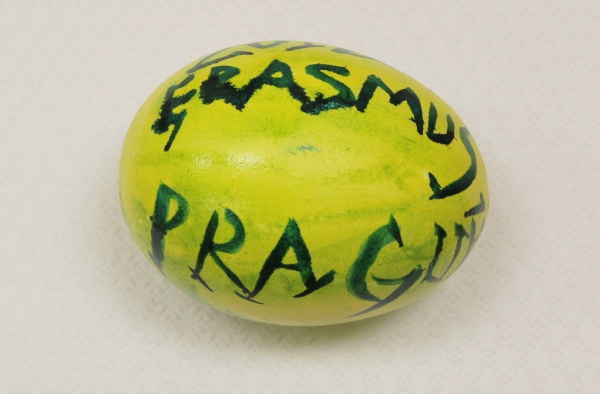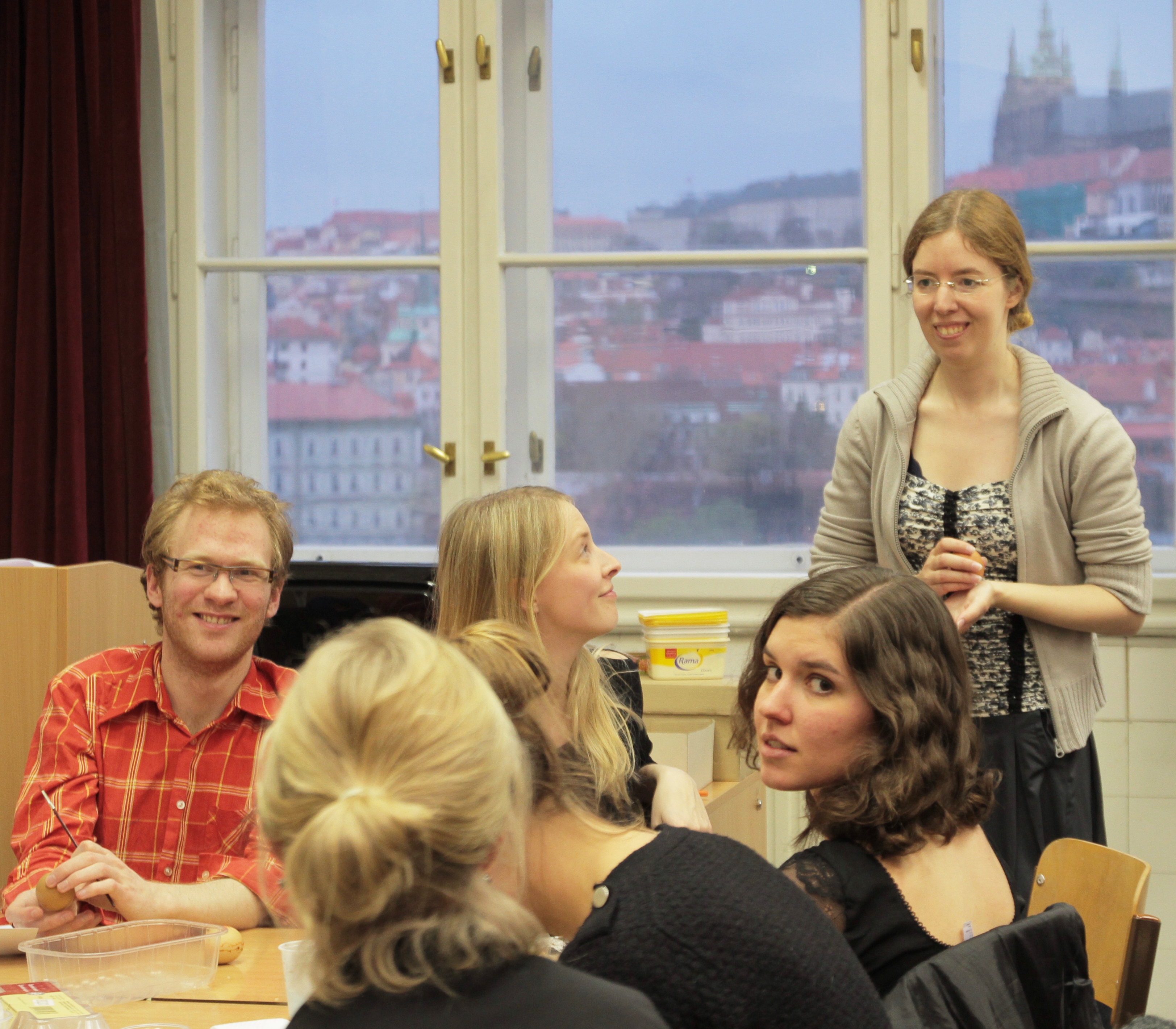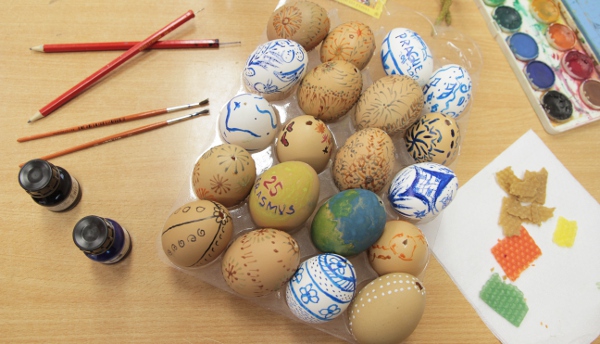10. 4. 2012; by: Erasmus students; Photo: Loreta Abidini; Proofreading: A. J. Campbell; Section: English Digest
It’s a tradition of the Erasmus Club at Faculty of Arts to invite the Erasmus students for a Czech Easter Afternoon on one of the Fridays before Easter holidays. This year, the Czech tutors (Jana, Tanja and Ivana) met with about 30 Erasmus students on Friday 30th March to share with them how Czech Easter is celebrated.
The Erasmus students were shown a recording showing the happening on Easter Monday morning, were told what a pomlázka is, were introduced to Czech Easter traditions in a PowerPoint presentation, and finally, were able to paint their own Easter eggs. Since the Erasmus programme celebrates its 25th anniversary this year, several of the students decorated their eggs for this occasion. During the whole afternoon, while decorating the eggs (with colours, blue ink or wax) and eating the Czech typical Easter cake, mazanec, the participants spontaneously shared their own Easter traditions.
Vincent McGowne from St. Patrick's College in Dublin, currently studying at Protestant Theological Faculty in Prague said: “I really enjoyed the Czech cultural Easter class, it was very informative. The history and cultural significance of the pomlázka was of great interests as many of these old traditions have been replaced by the religious events associated with the Easter period. In Scotland, as a child we used to also paint our (hard-boiled) eggs and then on Easter Sunday we would hike up the big hill in our village to roll our eggs (to symbolize the rolling of the stone at Jesus' tomb). As we lived in a Christian country this was done by the majority of the children in the village. Sadly, in the modern age and the advent of Easter chocolate eggs bought for children, this kind of cultural activity is also dying out, which is a pity because I have fond memories of rolling my eggs and eating them after!”
The Erasmus Club tutor Tanja Amtmann, a former Erasmus student at the Faculty of Arts herself (originally from University of Passau), who now lives and works in Prague, commented: “In the presentation to the Easter traditions the Czech tutor said that Easter is a celebration of spring. For me, this was almost an insult – for us, it’s the biggest church holiday. In the Catholic Church, we commemorate the death and the resurrection of Jesus Christ during the Easter holiday. The most important service takes places at night from Easter Saturday to Easter Sunday, in German we call it Osternacht (Easter Night). This service starts in the very early morning hours on Sunday, at 4 or 5 a.m. The priest sanctifies the traditional Easter food (bread, ham, eggs and horse-radish).
In Germany we have various Easter traditions. In my home region, Bavaria, Ostereierschieben (in Bavarian Oascheibn) is one of the most common customs. It is done this way: the whole family meets in the garden, were a bevel plate is ‘instalated’ for this occasion, made by putting more rakes next to each other. Everyone prepares a painted egg and lets it roll down this plate. The person whose egg remains whole wins. Sweets and colourful eggs are brought to the children by Osterhase, the Easter hare. Der Osterhase hides eggs and chocolate in the garden and the children must seek for them afterwards. That’s always fun.”
Erik Parmlind from Sweden, Erasmus student at Czech Technical University who regularly joins the events offered to the Erasmus students at Charles University said about Easter in Sweden: “Easter traditions in Sweden center on eggs and Easter women. The boiled eggs are decorated and consumed together with pickled herring, potatoes and Easter soda. Children are clothed as witches (with long skirts, colorful headscarves and painted red cheeks) and visit houses ringing the door and giving Easter cards. In return they receive candy or money. According to Swedish folklore, during Easter the witches fly to Blakulla (the Blue Mountain, a legendary hill somewhere in Germany) to meet the devil. For the majority of Swedish people, Easter is a time to travel and visit family.”
Stefana Mincheva from University of Plovdiv in Bulgaria (currently studying at the Faculty of Arts) commented: “Eastern Orthodox Church regards Easter as the most important holiday. In Bulgaria it is also traditionally celebrated as the rebirth of nature and coming of spring. It is a tradition for boys to sway their beloved girls on Easter swings. Before Easter we dance an open horo and during Easter we dance a circle horo. Horo is a traditional Bulgarian dance which is performed by boys and girls dancing hand in hand. The moves of the horo imitate the moves of a snake. It is believed that during Easter there is a high probability of zmei (dragon) coming to steal a bride out of the local girls. That is why there are many protective actions taken by the girls. They get up very early in the morning of Thursday before Easter, just before the sunrise. The girls collect herbs which are believed to have a special healing and protective power if collected on this day.
Another very important ritual is the painting of Easter eggs. It can take place either on Thursday or Saturday (never on Friday, however). The first boiled egg should be painted red by the oldest woman in the house as the sun rises. She makes crosses with the fresh painted egg on the forehead of everyone in the house beginning with the youngest child. After that this egg is placed in front of the icon of St. Mary with Jesus Child. Another red painted egg is left for the cattle in the barn and one is buried in the fields. After that more eggs are boiled and painted by the children. A traditional way of colouring eggs is using onion peels – we put leaves or flowers on the eggs, hold e.g. by gauze and then put them in the water with vinegar and onion peels. The Bulgarian people traditionally use many different kinds of dyes so that the eggs will be colorful. A often used saying is that the eggs are so decorated that ‘the hen would not recognize them.’ Another traditional way of painting Easter eggs in Bulgaria is egg drawing. For this a special instrument called perashka is needed. It is a wooden stick that has a hole in it. There is a metal nib fixed to it (made from a thin metal plate). You put wax in it and hold the nib over the flame of a candle. Then you can draw on the egg as long as the wax remains hot. Once the ornaments are drawn, the egg is put in colored ink or paint. Only the places covered by the wax will remain white or black (black if the wax was smoked). The Bulgarian traditional colour of Easter eggs is red.
We have a tradition to fight with eggs on Easter Monday. Egg fights or egg tapping is a symbol for fertility, something like Czech pomlázka. Everyone chooses an egg and then we crash them (all the eggs are boiled) at the pointed sides so that every time one egg is broken and the other is not. After that we fight with the round side of the eggs. If both eggs have one broken and one intact side, we would crash again the intact sides to see which egg wins. The egg that remained unbroken is called borets or borak, which means fighter. It is believed that the person who owns this egg will be healthy and happy all the year.
For Easter we prepare sweet bread which is called kozunak. It can be made with raisins, jam, dried fruits, sesame, walnuts or other nuts inside or on the top. For Easter Monday we make traditional Easter bread with boiled eggs inside it. The bread has a specific decoration or can be shaped as a braid.
It is very nice that this tradition is preserved and practiced by young people until today. I am very happy that Czech and Bulgarian people have similar traditions. Perhaps they might be our common Slavonic heritage.”



















